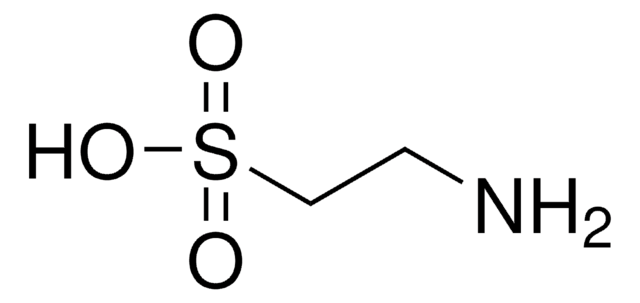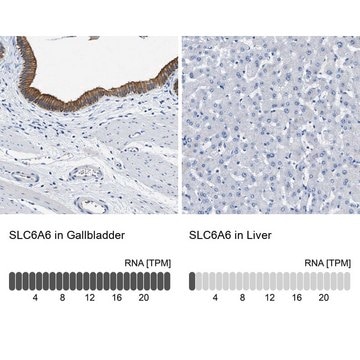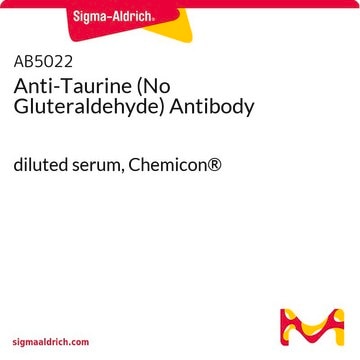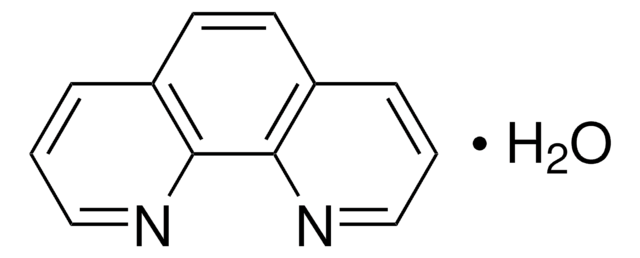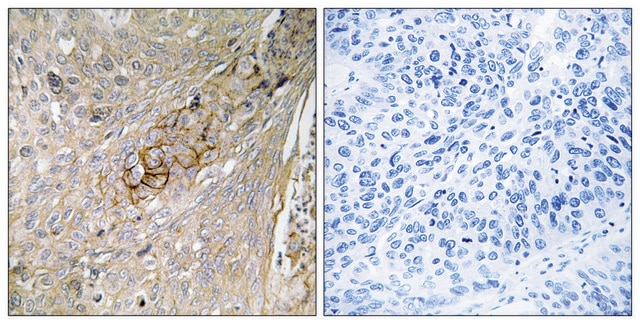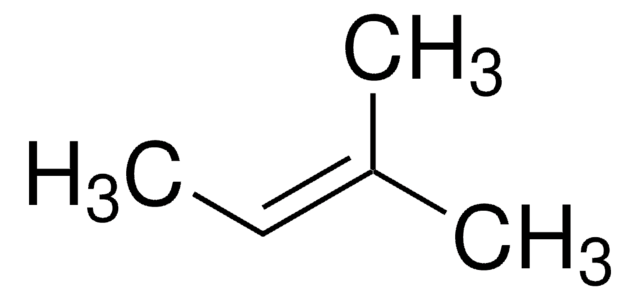AB5414P
Anti-Taurine Transporter Antibody
Chemicon®, from rabbit
Sign Into View Organizational & Contract Pricing
All Photos(1)
About This Item
UNSPSC Code:
12352203
eCl@ss:
32160702
NACRES:
NA.41
Recommended Products
biological source
rabbit
Quality Level
antibody form
affinity purified immunoglobulin
antibody product type
primary antibodies
clone
polyclonal
purified by
affinity chromatography
species reactivity
rat, mouse
manufacturer/tradename
Chemicon®
technique(s)
ELISA: suitable
western blot: suitable
shipped in
dry ice
target post-translational modification
unmodified
Gene Information
human ... SLC6A6(6533)
Specificity
Recognizes Taurine Transporter. The immunogen shows no significant sequence homology with other known proteins.
SPECIES REACTIVITIES: The immunogen shows 100% sequence homology with mouse and 90% with human and canine. Reactivity with other species has not been confirmed.
SPECIES REACTIVITIES: The immunogen shows 100% sequence homology with mouse and 90% with human and canine. Reactivity with other species has not been confirmed.
Immunogen
A 20 amino acid peptide near the carboxy terminal cytoplasmic region of rat Taurine Transporter (Smith et al. 1992; Liu et al. 1993; Uchida et al. 1992; Jhiang et al. 1993).
Application
Anti-Taurine Transporter Antibody is an antibody against Taurine Transporter for use in ELISA & WB.
Western blot: 1-10 μg/mL using ECL. Tau1 is approx 65-70 kDa.
ELISA: 1:10,000-1:100,000 using 50-100 ng control peptide (Catalog Number AG341) per well.
Optimal working dilutions must be determined by the end user.
ELISA: 1:10,000-1:100,000 using 50-100 ng control peptide (Catalog Number AG341) per well.
Optimal working dilutions must be determined by the end user.
Storage and Stability
Maintain at -20°C in undiluted aliquots for up to 6 months after date of receipt. Avoid repeated freeze/thaw cycles.
During shipment, small volumes of antibody will occasionally become entrapped in the seal of the product vial. For antibodies with volumes of 200 μL or less, we recommend gently tapping the vial on a hard surface or briefly centrifuging the vial in a tabletop centrifuge to dislodge any liquid in the container′s cap.
During shipment, small volumes of antibody will occasionally become entrapped in the seal of the product vial. For antibodies with volumes of 200 μL or less, we recommend gently tapping the vial on a hard surface or briefly centrifuging the vial in a tabletop centrifuge to dislodge any liquid in the container′s cap.
Other Notes
Concentration: Please refer to the Certificate of Analysis for the lot-specific concentration.
Legal Information
CHEMICON is a registered trademark of Merck KGaA, Darmstadt, Germany
Not finding the right product?
Try our Product Selector Tool.
wgk_germany
WGK 2
flash_point_f
Not applicable
flash_point_c
Not applicable
Certificates of Analysis (COA)
Search for Certificates of Analysis (COA) by entering the products Lot/Batch Number. Lot and Batch Numbers can be found on a product’s label following the words ‘Lot’ or ‘Batch’.
Already Own This Product?
Find documentation for the products that you have recently purchased in the Document Library.
Modulation of calcium channels by taurine acting via a metabotropic-like glycine receptor.
E Albi?ana,S Sacristan,R Martin del Rio,J M Solis,J M Hernandez-Guijo
Cellular and Molecular Neurobiology null
Ulrike Seidel et al.
Antioxidants (Basel, Switzerland), 9(11) (2020-11-05)
Taurine is a nonproteinogenic amino sulfonic acid in mammals. Interestingly, skeletal muscle is unable to synthesize taurine endogenously, and the processing of muscular taurine changes throughout ageing and under specific pathophysiological conditions, such as muscular dystrophy. Ageing and disease are
K E Smith et al.
Molecular pharmacology, 42(4), 563-569 (1992-10-01)
A cDNA clone (designated rB16a) encoding a taurine transporter has been isolated from rat brain, and its functional properties have been examined in mammalian cells. The nucleotide sequence of the clone predicts a 621-amino acid protein with significant homology to
Widespread microRNA dysregulation in multiple system atrophy - disease-related alteration in miR-96.
Kiren Ubhi et al.
The European journal of neuroscience, 39(6), 1026-1041 (2013-12-07)
MicroRNA (miRNA) are short sequences of RNA that function as post-transcriptional regulators by binding to target mRNA transcripts resulting in translational repression. A number of recent studies have identified miRNA as being involved in neurodegenerative disorders including Alzheimer's disease, Parkinson's
Our team of scientists has experience in all areas of research including Life Science, Material Science, Chemical Synthesis, Chromatography, Analytical and many others.
Contact Technical Service